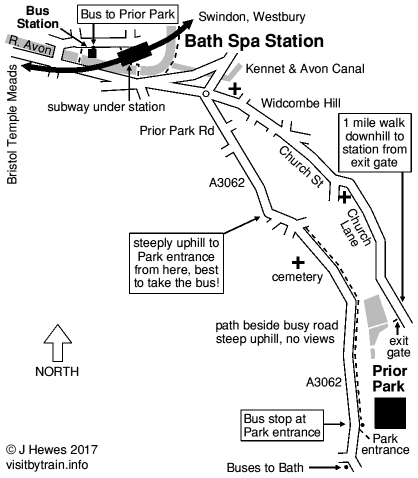Bath is an elegant city and World Heritage Site on the River Avon with many well-preserved Georgian buildings built from the local Bath stone. In Roman times it was known as Aquae Sulis and baths were built to use the natural hot mineral springs. Bath developed rapidly as a fashionable spa in the 18th century with a formal pattern of streets and buildings, fine examples include The Circus, Queen Square and Royal Crescent. The historic Pulteney Bridge is lined with shops.
Bath's railway station is called Bath Spa and the Bus Station is almost adjacent. Bath Spa PlusBus tickets are valid within the urban area, including to the University of Bath, the American Museum and Prior Park Landscape Garden.
Find a Bath private tour guide on GoWithGuide.
Founded in the 7th century, Bath Abbey was rebuilt in the 12th and 16th centuries and restored in the 1860s by
Sir George Gilbert Scott. The Abbey is built to a cruciform plan and is noted for its fan vaulting. Tower tours.
Free admission, donations welcome (charge for Tower tours).
Open M-S 1000-1730, Sun see website. Check website for changes.
www.bathabbey.org
The Roman Baths were built around a natural hot spring and the remains are remarkably complete.
The Baths are below modern street level with 19th century buildings above. A Museum contains finds from Roman Bath.
Audio guide and costumed interpreters. Refreshments in the 18th century Pump Room.
Open Daily 0930-1700, plus summer evenings (see website).
www.romanbaths.co.uk
A public art gallery with works by Gainsborough, Sickert, Turner and many other artists from the 15th century
to the present day. Free admission to main galleries.
Open TWThFSSu 1030-1700.
www.victoriagal.org.uk
A fine Georgian townhouse decorated and furnished as it might have been during the period 1776-1796.
Historic furniture, pictures and other items show what life was like for Bath's fashionable residents and their servants.
Events programme.
Open TWThFSSu 1000-1730.
www.no1royalcrescent.org.uk
An 18th century Gothic chapel housing a museum covering the development of Bath from a provincial town to a
fashionable Georgian city. Scale model of Bath.
Open closed for repairs, see website.
www.museumofbatharchitecture.org.uk
Home of the musician and amateur astronomer William Herschel and where he discovered the Uranus in 1781
using his home-made telescope (a replica is displayed). His modest townhouse has been restored to the period style,
contrasting with the grand houses such as No. 1 Royal Crescent (see above). Astronomical instruments. Music room. Garden.
Exhibitions programme.
Open TWThFSSu 1000-1700 (closed 1300-1400 SSu).
www.herschelmuseum.org.uk

An exhibition in a Georgian townhouse telling the story of Jane Austen's time in Bath and its
influence on her and her novels. Costumed character guides. Regency Tea Room.
Open Daily 1000-1700.
www.janeausten.co.uk
The collections represent more than 7000 years of artistry and craftsmanship from East and South East Asia,
including ceramics, jade, metalware, lacquerware, carvings and wood sculptures.
Open WThFS 1100-1600.
www.meaa.org.uk
A museum of Bath's industrial and commercial history, housed in an 18th century Real Tennis court.
Features include a reconstructed Victorian engineering works, soft drinks factory and Bath Stone mine and a car gallery.
Refreshments.
Open Apr-Oct, Daily 1030-1700. Nov-Mar, see website.
museumofbath.org
The history of fashion with garments from 1750 to the present day. Reproduction costumes for adults and children to try on.
Open closed for relocation.
www.fashionmuseum.co.uk
The magnificent Assembly Rooms were used for parties and balls in Georgian times.
Open expected to reopen in 2027, please see website.
www.nationaltrust.org.uk
The extensive fine and decorative art collection of Sir William Holburne plus further items added since his death in 1874.
Café. Exhibitions and events programme. Free admission (charge for temporary exhibitions).
Open Daily 1100-1700 (from 1000 M-S).
www.holburne.org
Bath Postal Museum has closed permanently.
American decorative and folk art housed in a Georgian mansion.
Gardens. Café. Exhibitions programme.
Open please see website.
www.americanmuseum.org
Bus U1 from Dorchester Street (near Rail Station, opposite Bus Station) to directly opposite The Avenue,
the first stop once the bus turns left into Norwood Avenue. Then ½ mile walk along The Avenue.
About 15 minutes journey, Daily every 10-15 minutes.
Bath Spa PlusBus tickets are valid for this journey.
Operated by First.

A landscape garden created on a hillside overlooking Bath. Woodland, Palladian bridge and lakes.
Visitors enter at the top and can walk down to the bridge and Tea shed by the lakes. An exit gate leads onto a lane
for a 1 mile downhill walk back to the station. Children's natural play area. Family trails.
Open Mar-Oct, Daily 1000-1700 (dusk if earlier). Nov-Feb, SSu 1100-1600.
www.nationaltrust.org.uk/priorpark
Bus 2 from Dorchester Street (near Rail Station, adjacent to Bus Station) to entrance.
6 minutes journey, M-S every 15 minutes, Sun & BH every 30 minutes.
Bath Spa PlusBus tickets are valid for this journey.
Operated by First.
I recommend taking the bus up to the entrance because the walk is steeply uphill along a busy road with no views
or other features of interest. The 1 mile return walk from the exit gate at the bottom of the garden is downhill and much better.
